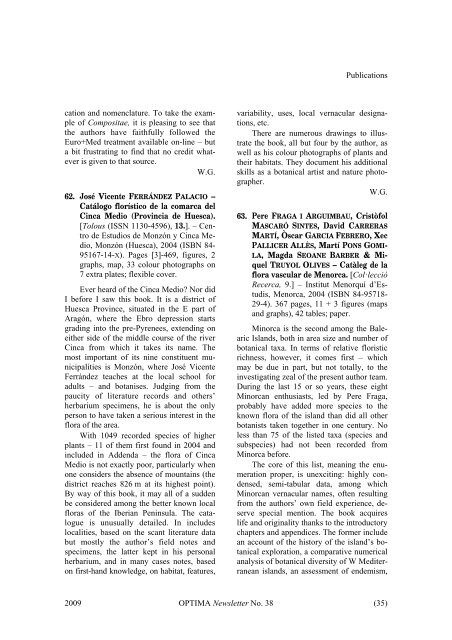OPTIMA Newsletter 38
OPTIMA Newsletter 38
OPTIMA Newsletter 38
You also want an ePaper? Increase the reach of your titles
YUMPU automatically turns print PDFs into web optimized ePapers that Google loves.
cation and nomenclature. To take the example<br />
of Compositae, it is pleasing to see that<br />
the authors have faithfully followed the<br />
Euro+Med treatment available on-line – but<br />
a bit frustrating to find that no credit whatever<br />
is given to that source.<br />
W.G.<br />
62. 61BJosé Vicente FERRÁNDEZ PALACIO –<br />
Catálogo florístico de la comarca del<br />
Cinca Medio (Provincia de Huesca).<br />
[Tolous (ISSN 1130-4596), 13.]. – Centro<br />
de Estudios de Monzón y Cinca Medio,<br />
Monzón (Huesca), 2004 (ISBN 84-<br />
95167-14-X). Pages [3]-469, figures, 2<br />
graphs, map, 33 colour photographs on<br />
7 extra plates; flexible cover.<br />
Ever heard of the Cinca Medio? Nor did<br />
I before I saw this book. It is a district of<br />
Huesca Province, situated in the E part of<br />
Aragón, where the Ebro depression starts<br />
grading into the pre-Pyrenees, extending on<br />
either side of the middle course of the river<br />
Cinca from which it takes its name. The<br />
most important of its nine constituent municipalities<br />
is Monzón, where José Vicente<br />
Ferrández teaches at the local school for<br />
adults – and botanises. Judging from the<br />
paucity of literature records and others’<br />
herbarium specimens, he is about the only<br />
person to have taken a serious interest in the<br />
flora of the area.<br />
With 1049 recorded species of higher<br />
plants – 11 of them first found in 2004 and<br />
included in Addenda – the flora of Cinca<br />
Medio is not exactly poor, particularly when<br />
one considers the absence of mountains (the<br />
district reaches 826 m at its highest point).<br />
By way of this book, it may all of a sudden<br />
be considered among the better known local<br />
floras of the Iberian Peninsula. The catalogue<br />
is unusually detailed. In includes<br />
localities, based on the scant literature data<br />
but mostly the author’s field notes and<br />
specimens, the latter kept in his personal<br />
herbarium, and in many cases notes, based<br />
on first-hand knowledge, on habitat, features,<br />
Publications<br />
variability, uses, local vernacular designations,<br />
etc.<br />
There are numerous drawings to illustrate<br />
the book, all but four by the author, as<br />
well as his colour photographs of plants and<br />
their habitats. They document his additional<br />
skills as a botanical artist and nature photographer.<br />
W.G.<br />
63. 62BPere FRAGA I ARGUIMBAU, Cristòfol<br />
MASCARÓ SINTES, David CARRERAS<br />
MARTÍ, Òscar GARCIA FEBRERO, Xec<br />
PALLICER ALLÈS, Martí PONS GOMI-<br />
LA, Magda SEOANE BARBER & Miquel<br />
TRUYOL OLIVES – Catàleg de la<br />
flora vascular de Menorca. [Col·lecció<br />
Recerca, 9.] – Institut Menorquí d’Estudis,<br />
Menorca, 2004 (ISBN 84-95718-<br />
29-4). 367 pages, 11 + 3 figures (maps<br />
and graphs), 42 tables; paper.<br />
Minorca is the second among the Balearic<br />
Islands, both in area size and number of<br />
botanical taxa. In terms of relative floristic<br />
richness, however, it comes first – which<br />
may be due in part, but not totally, to the<br />
investigating zeal of the present author team.<br />
During the last 15 or so years, these eight<br />
Minorcan enthusiasts, led by Pere Fraga,<br />
probably have added more species to the<br />
known flora of the island than did all other<br />
botanists taken together in one century. No<br />
less than 75 of the listed taxa (species and<br />
subspecies) had not been recorded from<br />
Minorca before.<br />
The core of this list, meaning the enumeration<br />
proper, is unexciting: highly condensed,<br />
semi-tabular data, among which<br />
Minorcan vernacular names, often resulting<br />
from the authors’ own field experience, deserve<br />
special mention. The book acquires<br />
life and originality thanks to the introductory<br />
chapters and appendices. The former include<br />
an account of the history of the island’s botanical<br />
exploration, a comparative numerical<br />
analysis of botanical diversity of W Mediterranean<br />
islands, an assessment of endemism,<br />
2009 <strong>OPTIMA</strong> <strong>Newsletter</strong> No. <strong>38</strong> (35)






